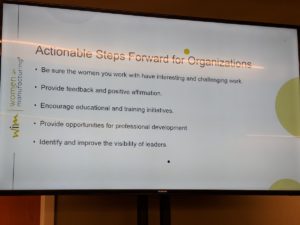 Opening this week’s Additive Manufacturing Symposium at Science in the Age of Experience, Allison Grealis, Founding President of Women in Manufacturing, took attendees on a journey of discovery surrounding the workforce. As 3D printing integrates more into the broader manufacturing industry, with production capabilities increasing and on-site installations rising, a skills gap remains a significant challenge and barrier to faster and broader adoption. The workforce in manufacturing, both existing and future, is in focus for Women in Manufacturing and other industry organizations striving to focus on the human aspect of industry.
Opening this week’s Additive Manufacturing Symposium at Science in the Age of Experience, Allison Grealis, Founding President of Women in Manufacturing, took attendees on a journey of discovery surrounding the workforce. As 3D printing integrates more into the broader manufacturing industry, with production capabilities increasing and on-site installations rising, a skills gap remains a significant challenge and barrier to faster and broader adoption. The workforce in manufacturing, both existing and future, is in focus for Women in Manufacturing and other industry organizations striving to focus on the human aspect of industry.
The skills gap is an issue in itself, and a particular piece of that puzzle comes in the form of diversity of workforce. The Additive Manufacturing Symposium’s morning plenary session kicked off with Grealis’ presentation, “The State of Women & Additive Manufacturing,” laying the foundation for an informative day of industry discussion. Organizations, she explained, are becoming ever more aware of the need for diversity and the tangible benefits of a workforce drawing from more diverse backgrounds, applicable to all levels from production line to C-suite. The latter of these sees a notable lack of diversity, wiith women representing a minority. She cited figures to note that while women make up 49% of the US labor force, they represent only 29% of the manufacturing workforce. These figures have been rising, but disparity remains, as reported in studies from McKinsey and, targeted to additive manufacturing, Alexander Daniels Global.
In her presentation, Grealis discussed actionable steps that organizations can take to ensure that they bring in a strong variety of personnel throughout operations, as well as actionable steps women can take in pursuing manufacturing careers.
Organizations can:
- Be sure the women you work with have interesting and challenging work
- Provide feedback and positive affirmation
- Encourage educational and training initiatives
- Provide opportunities for professional development
- Identify and improve the visibility of leaders


Women in additive can:
- Establish a relationship with a mentor / become a mentor
- Be visible! Take opportunities to speak on behalf of the industry / share your story
- Educate and encourage the next generation of talent
- Rise the ranks by positioning yourself for success / pave the way for others
- Meet and connect with other like-minded industry women
 Later in the day, I appreciated the opportunity to sit down with Grealis and discuss more of the issues and solutions for workforce development in additive manufacturing — an immediate illustration of her last action point for women, as it happened.
Later in the day, I appreciated the opportunity to sit down with Grealis and discuss more of the issues and solutions for workforce development in additive manufacturing — an immediate illustration of her last action point for women, as it happened.
“Workforce is the key issue we’re combating,” she told me.
“This is one of the things that’s been a core focus for the organization since we got started. The skills gap is a big focus. When we talk to most companies, they have a slew of positions they’re seeking to fill, and we believe our organization can be a resource to filling those gaps. There are new opportunities that technology and additive manufacturing represent to women and men alike. We have a focus on the public perception issue, trying to influence a more positive image of manufacturing; we focus on parents, educators, and career counselors as much as on students and budding professionals. We share new technology components that would entice new workers and help to dispel myths that would discourage them.”
Initiatives surrounding workforce development represent a critical focus, Grealis underscored, with education and training imperative to the growth of a more advanced manufacturing sector. Encouraging the growth of women in the industry is a widespread effort, with many companies having created women’s affinity groups. Some of these, though, are groups in name alone, she said, and Women in Manufacturing is “working to create real vehicles to provide women with resources — in their company, and resources outside their individual company.”

One of the organization’s efforts is its Leadership Lab for Women in Manufacturing, launched with Case Western Reserve University’s (CWRU) Weatherhead School of Management and the support of the Women in Manufacturing Education Foundation (WiMEF). This Leadership Lab was launched in response to companies’ feedback that they had rising leaders in their ranks who weren’t yet equipped with all they needed, Grealis said. That type of responsiveness to real-world needs is necessary for the growth of positive structural development and encouraging leadership from within. Grealis pointed to efforts fostering training for management aptitude needed for success in leading teams and leading functions of responsibility within their organizations.
“Virtual training and learning is very important to us; we want to greatly expand this in the next few years,” she added. “We want to get down into the ranks to more women in manufacturing, many of whom don’t have the travel budget to go to Boston or Indianapolis [where WiM hosts events], and provide resources in how to get more training than just opportunities on the shop floor.”
Providing solutions is integral to Women in Manufacturing’s work and interest, as the organization seeks to “be a key solution provider to find and train and retain talent.” Since 2012, they have offered a direct job board through which companies can directly post jobs and job seekers can see what’s available, including apprenticeships and training, she noted. Networking is also key to the efforts, and advanced networking groups enable a valuable human resources resource, as well as a group for owners and senior executives. Discussion of best practices, and of support and advice, enables a unique setting “that isn’t happening naturally” as these twice-yearly events provide a confidential setting to talk about business.
“With all these efforts, the hope is to grow that percentage that we talked about this morning — we want to see that 29% rise closer to 50%. We want to grow not only the hourly ranks or the management ranks, but also C-suite ranks. Often there it’s under 10%, or single-digit, which is pretty disappointing,” Grealis continued.
“If you look at Forbes’ ranks of top female executives, the key most powerful women in business, most are with manufacturing companies, which is exciting. Now, we need to see more of them, to duplicate that ten-fold and fill more boardrooms with women. Most of those women came through the ranks. Most came up through technical fields, engineering and the like, and rose to lead these companies forward.”
Forbes’ list showcases an impressive array indeed of strong women leading businesses, and includes powerhouse quotes from powerhouse women. The list cites an interview with the Wall Street Journal from Mary Barra, CEO of General Motors and named at number five on the Forbes list:
“Cultivating diversity isn’t about taking a gender count when you walk into a room. It’s about valuing all ideas and building teams with different backgrounds and experiences.”

Looking specifically at additive manufacturing and the revolution surrounding digitization and an increase in cloud and other virtual resources, I asked Grealis how she saw these new technologies reshaping manufacturing and impacting the workforce.
“There should be more opportunities now. It’s not a women’s issue; it’s a people issue,” she said.
“Virtual capabilities are making work more humane; we don’t want to make work life. Companies are becoming more virtual, more flexible, and this makes not only manufacturing more appealing to women, but to millennials, to more generations — it’s become an attractive piece of manufacturing. You can’t just stop the manufacturing line because people want to go home. Virtual offerings, smart machines, and flexible hours are making more possible.”
She pointed to the example of a plant manager she spoke with recently who has found herself in a more humane work environment due to the flexibility enabled by checking virtually on production, allowing her to work more appealing hours while still keeping tabs on the happenings on the line.
For her part, Grealis’ background, with her father working in manufacturing, provided early exposure to these environments and providing a foundation from which she could understand the unique needs in manufacturing.
“I liked the excitement piece that it wasn’t dull; it’s not a traditional office intern experience when helping with things. Early exposure made me more open and excited when I came to metal forming after college,” she said. “I’ve always been very passionate about women’s issues. I’ve had a core passion always about advocating, and even thought for a short minute I would be a criminal lawyer. It’s come full circle to create an organization illuminating a population in manufacturing not often seen or heard from. I worked for a trade association working with metal forming companies, and worked with women leaders in metal forming. I found their unique needs were no different than women in different parts of manufacturing. At the tim, there wasn’t a resource around these individuals, and so we decided to start a conference that became our full service organization. It’s great to help provide power and support to this amazing community.”
Women in Manufacturing will be hosting its summit October 3-5 in Indianapolis, including several plant tours and networking events, alongside gathered experts, workshops, and roundtables.
Discuss workforce, Women in Manufacturing, and other 3D printing topics at 3DPrintBoard.com or share your thoughts in the Facebook comments below.
[All photos: Sarah Goehrke]

































